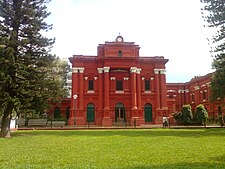Government Museum, Bangalore
 |
|
| Established | 18 August 1865 |
|---|---|
| Location | Kasturba Road, Bangalore, India |
| Collection size | Sculpture, old jewellery, coins and inscriptions. |
| Visitors | 90,000 per annum |
Government Museum (Bangalore) established in 1865 by the Mysore State with the guidance of Surgeon Edward Balfour who founded the museum in Madras and supported by the Chief Commissioner of Mysore, L.B. Bowring is one of the oldest museums in India and the second oldest museum in South India. It is now an archaeological museum and has a rare collection of archaeological and geological artifacts including old jewellery, sculpture, coins and inscriptions. The museum is also home to the Halmidi inscription, the earliest Kannada inscription (450 AD).
The government museum in Bangalore was established on 18 August 1865, during the period when L.B. Bowring was Chief Commissioner of Mysore State. A formal official notification was issued in the Mysore Government Gazette on 17 April 1866, a copy of which is still preserved in the Karnataka State Archives in Bangalore. The gazette notification officially invited citizens to contribute cultural and natural artifacts to the museum for display.
The museum was founded at the advice and counsel of Edward G. Balfour, a medical officer of the Madras Army, transferred to Bangalore from Madras. Balfour suggested setting up a museum similar to the museum he had previously established in Madras in 1851. Balfour had organized collections for the Great Exhibition of 1851. Balfour had a collection of zoological and natural specimens to exhibit in the Museum. The Government museum in Bangalore was then known as the Mysore Government Museum and the building opened in 1877 was located on what was then Sydney road (today Kasturba road).
The museum was first established at the Cantonment's jail building. It continued to function there for 13 years until 1878.
...
Wikipedia
